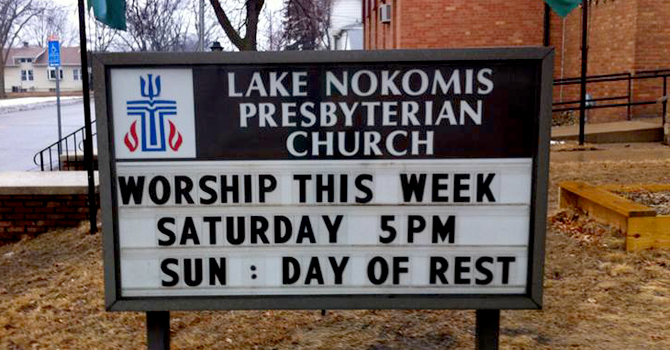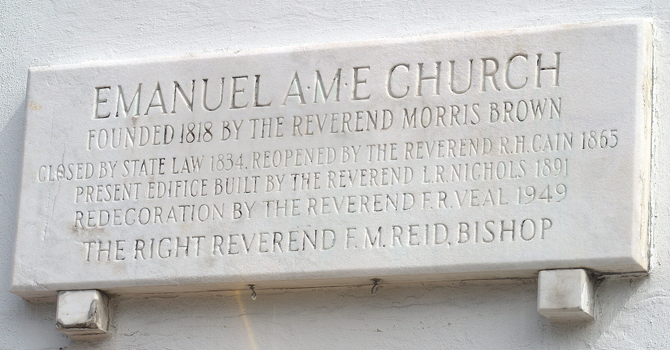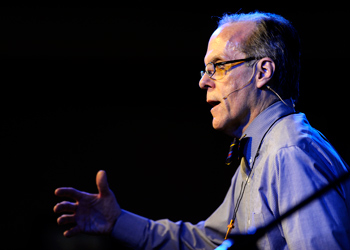Editor’s note: Faith & Leadership offers sermons that shed light on issues of Christian leadership. This sermon was preached at Hope College in Holland, Mich., on Oct. 21, 2012.
I am sometimes asked what I like about working at a college. One of my answers is that I like working at a college because it is a place that holds together an important tension: the tension between tradition and innovation. We are here to learn from the past, but also to press that learning forward into new knowledge, insights and wisdom. Sometimes you need just the right tension to sound just the right note.
I love tradition. Tradition is a humble reminder that we don’t exist in a vacuum. Tradition can give us a sense of orientation as it seeks to pass forward the best thinking and practices of those who have gone before us.
Tradition can invite humility. Tradition reaches far back into history, so that the dead might find a voice among the living. Tradition allows us to participate in a history that is always breathing. I love tradition.
At the same time, I also love innovation. I love the new idea, the fresh insight that comes with saying, “Why couldn’t we do it this way? Why can’t it be different?”
Innovation is the seedling of great hopes. It’s why I love the entrepreneurs -- the discoverers, the researchers, the explorers. I’m one of those rare citizens who actually think we should support NASA. The human soul needs to reach for the stars!
But like anything good, innovation can turn bad, even ugly. Innovation is good when it pushes us to think creatively to solve old problems and seek to find new horizons; innovation turns bad when one thinks naively that what’s new is always better, and that the old ways have nothing, really, to say to us. And innovation can be ugly when it takes on the zeal of the iconoclast or revolutionary who attacks cherished beliefs and institutions, thinking that if we could just wipe it all away, we would be free to engineer a brave new world.
Likewise with tradition. Tradition is good when it is a servant; tradition is bad when it seeks to be a master. Tradition is ugly when it is used as a blunt weapon against others. This is especially true in religion. When religious tradition becomes legalistic or takes on a religiosity that looks for fault, when it shuts down questions or shames people into conformity, the tradition is ugly.
I dare say that many people have lost their faith in Christ, or been turned off from faith, by just this sort of ugly experience.
Tradition and innovation -- it is the great tension. The wise leader is one who is able to hold this tension together. It’s not easy.
This is one of the reasons why I love Jesus. Jesus is able to hold the tension between the tradition of Israel on the one hand and the innovation of God on the other in such a way that when he speaks he sounds just the right note, so that we might all sing a new song.
Two stories
In Mark’s Gospel, we have two stories stitched together. The first story is about fasting; the second story is about the Sabbath -- what is lawful to do and not do on the Sabbath. In both stories, Pharisees are mentioned.
Now, I know the Pharisees get a bad rap. We are not supposed to like Pharisees. But I have a confession: I like them. I’m at least extremely sympathetic.
The Pharisees were the ones who, over centuries, created a scribal tradition that kept Israel’s identity and soul -- God’s covenant people -- from being swallowed up by the pagan assumptions of Hellenism. It may be argued that it was because of the Pharisees that Judaism even survived. It was the Pharisees who kept Israel’s tradition alive by a passionate integration of the law with daily life.
The Pharisees were not an organized structure. They had no primary leader. They were self-appointed keepers of the tradition. This attracts a particular kind of person. Usually it draws people who are a little self-assured and argumentative. There was good in what they did. But there was also bad. And there was also ugly.
These self-appointed keepers of the tradition created a culture of religiosity, of legalism, that in fact actually threatened the meaning and purpose of the tradition they were trying to protect. The danger of the Pharisees was that they were so focused on looking back on the tradition of the law that they lost sight of what the law was for. They were so focused on the tradition that they were blind to God’s innovation.
Three images and one day
Jesus is questioned about fasting. People notice that his disciples are not like the disciples of John or the Pharisees. The Pharisees fast. But Jesus’ disciples do not fast. Why is that?
Now, a note on the tradition of fasting. The Old Testament specified only one day when fasting was mandatory upon all Israel. This was the Day of Atonement, designated as a day for cleansing from sin and affliction of the soul. In this context, fasting was an act of repentance in preparation for forgiveness.
By the close of the prophetic period, other occasions of fasting had become traditional, and these observances continued into the first century. There is nothing in the tradition that said Jews needed to fast regularly. However, at this time it was customary for the Pharisees to fast voluntarily on Monday and Thursday of each week. Fasting was supposed to be an expression of sincere piety.
Why weren’t Jesus’ disciples following this practice of piety? Good question. Jesus answers with three images: wine, a garment and a wedding. Each of these images is a way for Jesus to answer the question on a tradition that at the same time innovates the tradition.
First, the wine. Jesus is saying that there is new wine. And in this context, he is saying something even more innovative. He is suggesting that he is the new wine. The old wineskins, the tradition of the scribes, are going to burst if they are expected to hold Jesus in.
Second, the garment. No one sews a piece of unshrunk cloth on an old cloak. It will pull away and create a greater tear. Jesus is saying he is a new patch on an old tradition. If you try to sew Jesus into this old cloak, it’s going to create a bigger tear.
The third image is of a wedding. You don’t fast when the bridegroom is with you but when the bridegroom leaves. A day will come for fasting, but it’s not right now. Jesus is the bridegroom. He is saying, “Because I am here -- the bridegroom is near -- now is not the time to fast. Now is the time to celebrate. The bridegroom has come for Israel.”
Jesus’ answer suggests that as long as he’s here, among them, that it’s not time to fast -- it’s time to party. Strike up the band, and bring out the wine!
Jesus’ presence means that God’s covenantal promise and saving presence for Israel is in the midst of the people. But the Pharisees can’t see this reality. Jesus’ answer says, “Look forward, not back.” But the problem is that the people can’t see what’s right in front of them. They are so anxious about not doing what’s wrong, they can’t see what’s right.
It’s the same problem the Pharisees have with Jesus concerning the Sabbath. Jesus and the disciples are walking through a field. His disciples are plucking heads of grain.
Pharisees interpret this as work, and a violation. So they ask Jesus, “Why are your disciples doing what is unlawful on the Sabbath?” The Pharisees are looking for fault. They want to use the tradition as a way to put Jesus in his place. The tradition has become a master, not a servant.
Isn’t it interesting how Jesus answers? Look at verse 25: Jesus answers by appealing to the tradition. “Have you never read what David did when he and his companions were hungry and in need of food? He entered the house of God, when Abiathar was high priest, and ate the bread of the Presence, which it is not lawful for any but the priests to eat, and he gave some to his companions” (NRSV).
Jesus’ answer is to appeal to the tradition he’s being accused of violating to press a particular point. The point is that you Pharisees are missing the point: “The sabbath was made for humankind, and not humankind for the sabbath; so the Son of Man is lord even of the sabbath” (verses 27-28).
This teaches us that Jesus interprets the tradition by keeping the spirit of the tradition. He lets the tradition of Scripture interpret the Scripture for him. The Word interprets the world.
Jesus’ response also teaches us that he knows the tradition. It teaches us that Jesus is no iconoclastic revolutionary. He is not saying not to fast. He is not saying ignore the Sabbath tradition. He is helping the Pharisees see the Sabbath in its proper context. That context can only be understood in light of himself -- the lord of the Sabbath.
This is critical to get right. It’s important to see that Jesus is not over against his own tradition. He was a Jew. He was a religious Jew. Jesus respected and kept the tradition of the law. He taught in the synagogues and at the temple. When people say, “I love Jesus, but I don’t like the church; I’m like Jesus -- I’m spiritual, but I’m not religious.”
Well, I’m sorry to tell you, that is not Jesus. Jesus was always in conversation within his religious tradition. He was never outside it. But he absorbed the tradition in such a way that he couldn’t help but innovate it.
Jesus innovates the scribal tradition in light of himself, because he is the light from true light. The Word made flesh. He is “the image of the invisible God, the firstborn of all creation; for in him all things in heaven and on earth were created; … he himself is before all things, and in him all things hold together” (Colossians 1:15-17).
As such, Jesus innovates not for innovation’s sake. His goal is not novelty. The best innovators are those that absorb a tradition so deeply that they begin to see a new way forward. The way forward is to see clearly who Jesus is. Jesus is not only the way forward; he is also the destination.
This is significant to keep in mind. In the Reformed tradition, there is a phrase often repeated: we are a tradition that is “reformed and always reforming.” This means that the Reformed tradition is one where we embrace the new thing God is doing right now.
But “reformed and always reforming” is not the full quote. The Reformed tradition is one that is “reformed and always reforming by the Word of God.” In other words, we don’t innovate out of cultural conformity; we innovate only in light of Jesus’ word and presence -- the Word made flesh.
Our tradition is to innovate in light of Jesus himself. What Jesus is saying to the Pharisees, and to us, is that Jesus is not only the way through the tradition; he is the one who gives tradition its meaning.
Jesus’ declaration that the Sabbath is not made for humanity but humanity for the Sabbath, so that the Son of Man is lord even of the Sabbath, is saying something innovative about the source of the tradition. Jesus is saying something fundamental about himself. He is saying that the Sabbath is a gift from God, and that the gift giver is himself. Now, this is a bold new innovation.
The new
Jesus loves the tradition, because the meaning of the tradition points to himself. Jesus says in Matthew’s Gospel that he has come not to abolish the law or the prophets but to fulfill them. The tradition of God’s innovation in Israel leads us to Jesus, who is lord of the Sabbath.
Jesus is God’s eternal Sabbath rest; Jesus is the bridegroom we celebrate at the wedding feast; Jesus is the new cloak of righteousness we put on every day; Jesus is the new wine that intoxicates us with wonder; Jesus is the tradition of the Word innovating a new world, where the old things have passed away and the new thing has begun!








